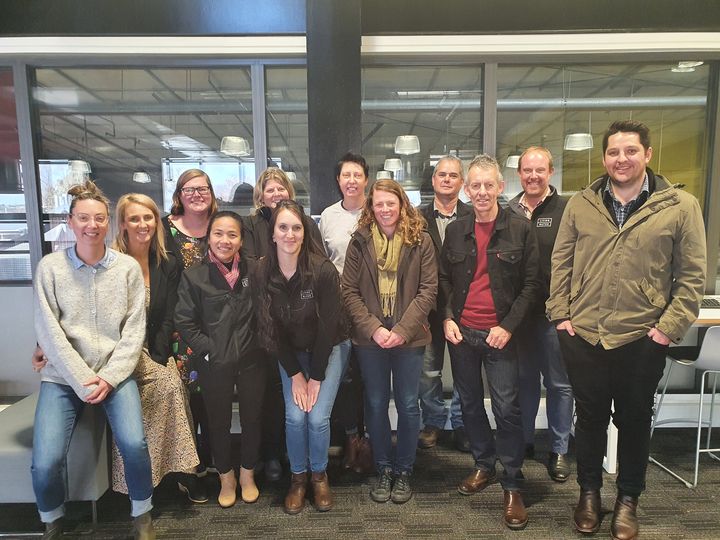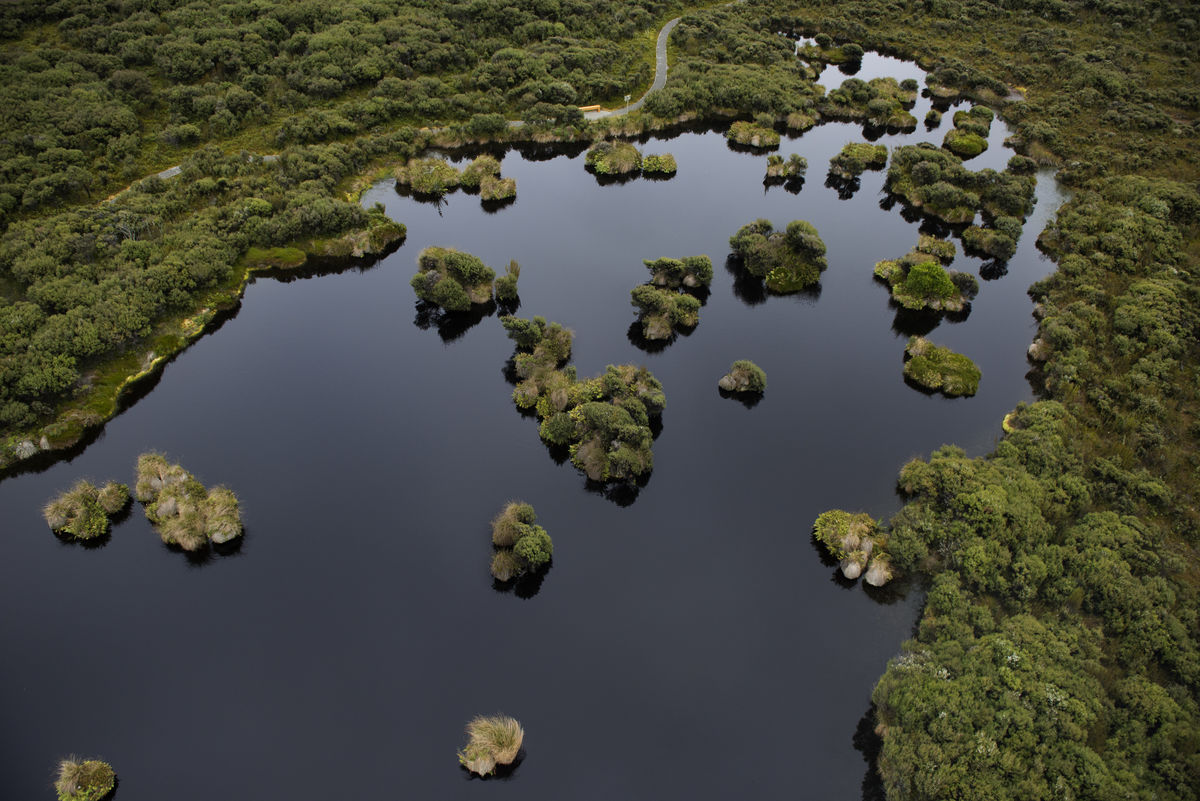
Progress summary update 2021
We recently celebrated eight years of working together with Fonterra in our Living Water Partnership, driving change and finding solutions to improve freshwater ecosystems and increase biodiversity in agricultural landscapes.
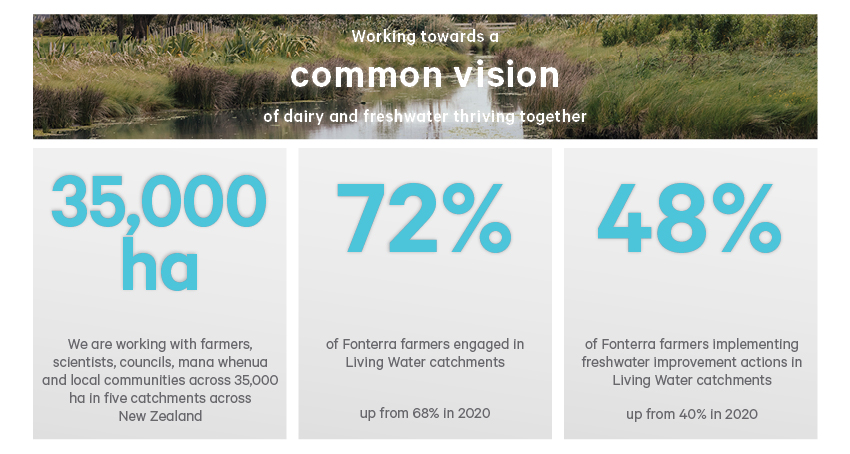
Working towards a common vision of dairy and freshwater thriving together
Across five catchments we’re working with farmers, scientists, mana whenua and local communities to trial a range of tools and approaches to improve freshwater.
We’ve developed farm environment plans for 72% of Fonterra farmers in our catchments, all of which include actions to improve freshwater. In addition to having a farm environment plan, 48% of the Fonterra farmers are taking steps that go above and beyond current regulations to improve freshwater, including riparian planting, installing mitigations like a detention bund or a peak run-off control structure on their land, improving fish habitat and protecting and enhancing wetlands. These actions taken over multiple farms are a significant step towards improving freshwater in each catchment.
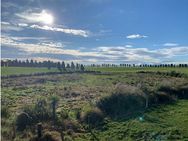
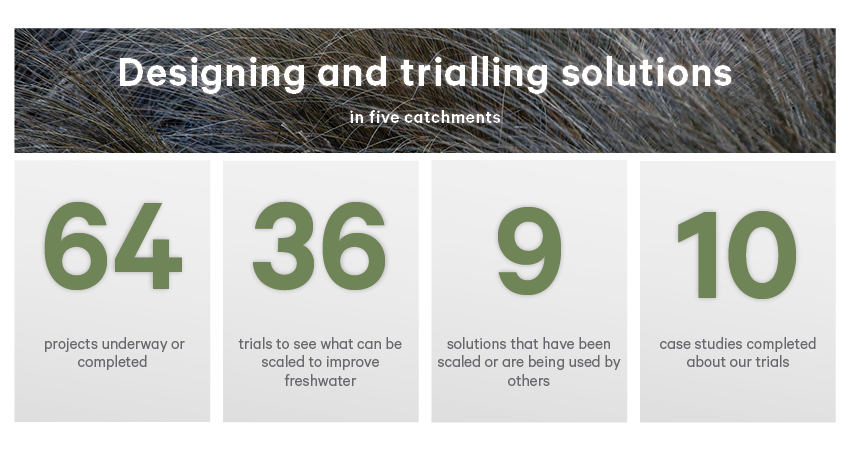
Designing and trialling solutions in five catchments
We’re trialling tools and approaches that can be scaled up to help improve freshwaters across Aotearoa New Zealand. This includes on-farm tools, catchment-based solutions, and addressing implementation barriers like funding, consenting, capability and waterway management.
Thirty-six trials are underway or completed. An on-farm example is a woodchip bioreactor being trialled in Ararira/LII, Canterbury to reduce nitrates. Installation was easy – it consists of bags of pine woodchips anchored in an intermittently flowing waterway. If successful, in-stream tools like this could be used in key areas around the country.
Catchment scale projects, like the Waituna physiographics project, have shown us where to place interventions within catchments to enable them to be most effective. The locations of the peak run-off control structures that are being trialled was directed by the evidence the physiographic project provided us, as well as giving us information about where the best places are to construct large-scale wetlands to reduce nutrients reaching Waituna Lagoon. Site Lead Pat Hoffmann has just stepped into the role there and has already been out with Fonterra Sustainable Dairying Manager Cain Duncan to look around the structures and meet the landowners in the community.
In Pūkorokoro-Miranda, the Catchment Condition Survey and CAPTure tool have given us similar information, allowing the Western Firth Catchment Group to work together on planting steep banks where erosion has been causing sediment in a main waterway. They’ve fenced and planted large areas and Site Lead Dion Patterson and Biodiversity Ranger, Rose Graham have been building relationships in the community for many years, leading to the collaboration of community groups, landowners and the Pūkorokoro-Miranda Naturalists Trust all working together toward common goals. They have helped create a Community Trust that is now responsible for managing the restoration of a new reserve that was previously farmland, to increase shorebird habitat in this highly valued and sensitive coastal environment.
Head over to our tools and solutions page to read more about our projects.
Nine solutions have been scaled to other sites by others, allowing us to look at how to lower the cost of implementing these tools and achieve environmental outcomes at a catchment wide scale. We’ve completed 10 case studies about our completed projects including floating wetlands, nitrogen and phosphorus filters, the CAPTure tool and more. Head over to the case studies and resources section of our website to check them out. This page will be updated more frequently as we approach the end of our projects.
Stay up to date by signing up to our newsletter.
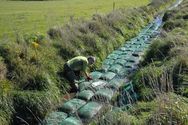
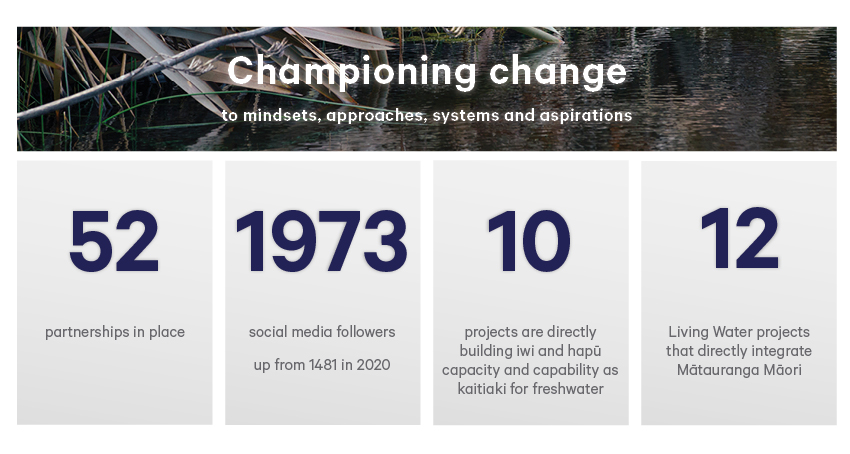
Championing change to mindsets, approaches, systems and aspirations
Over the past eight years, we have developed strong relationships both nationally and within our focus catchments. From this, we have forged 52 partnerships, recognising that no single organisation or sector has all the skills, knowledge or influence to improve freshwater and we know it requires more than just on-farm action. By partnering we are making it easier for farmers, iwi and communities to accelerate freshwater improvement.
The partnerships vary in nature from place to place, for example DOC’s partnership with the Department of Corrections, Good to Grow, helps rehabilitate offenders by connecting them to the land. In the Waikato Peat Lakes they have transformed the Lake Ruatuna recreation area by improving the amenity block, removing pest plants, creating a walking track and more recently they contoured an area ready for the creation of a pā harakeke. This project is in partnership with Ngāti Apakura where a variety of harakeke species have been planted with the intention of them being used for traditional weaving, along with rongoā plant species significant in Māori medicine. “We want to develop an education trail at the site so visitors can learn about the importance of these plant and tree species for matauāranga Māori,” Site Lead Dion Patterson says. This is only a small selection of the work happening in this catchment. Dion and Rose also work closely with landowners, the Ōhaupō community, National Wetland Trust, Te Mapi Ngāti Hauā Mahi Trust and many more on projects in the area.
By partnering we’re sharing the lessons learned over the last eight years. In the Ararira/LII we’ve partnered with Selwyn District Council, Te Taumutu Rūnanga, Environment Canterbury and the LII Drainage Committee, to develop a shared vision for the Ararira/LII catchment and support the development of an integrated catchment plan. This project is the result of several years of work from Site Lead Robin Smith who has worked with the University of Canterbury’s CAREX team to understand how the waterways function on the plains and how to bring back natural qualities to important habitats.
Ten of our projects are directly building iwi and hapū capacity and capability as kaitiaki for freshwater. One of these is our work with Ngā Kaitiaki O Ngā Wai Māori in Wairua, Northland who for two years volunteered alongside Living Water staff doing the monthly water quality monitoring run to learn the methods. They are now contracted to carry out the monitoring run and undertake a twice-yearly fish survey within the catchment. Site Lead Anh Nguyen and previously Andrew Kirk have been working closely alongside Ngā Kaitiaki O Ngā Wai Māori to combine western science and mātauranga Māori. Living Water is also one of seven members that make up the Waimā Waitai Waiora partnership, a project aimed at improving water quality in the Northern Wairoa River and its tributaries. The partnership has planted over 35,000 trees in the Upper Wairua catchment.
We share our project updates, lessons learned, news and people on our social media channels. The amount of growth in this area shows a real interest in results and the sharing of what works and what doesn’t.
The future of farming will be different and we’re working together on what this could mean for farming and freshwater. By partnering together and using our unique strengths, we can accelerate freshwater improvement for Aotearoa New Zealand. Full progress summary available here

